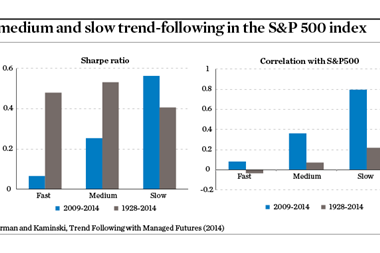IPE contributing editor Joseph Mariathasan explores whether hedge funds can justify their fees
Hedge funds have always been a controversial area for pension fund investment. Quite apart from the opaque nature of many strategies and the esoteric nature of where the returns are supposedly coming from, the traditional fee structure of 2% management plus 20% performance hits you in the face.
It should be a worrying time for the hedge fund industry. Last year saw the largest US pension scheme, CalPERS, pulling out of all hedge funds, and this year has already seen PFZW, the second-largest pension scheme in the Netherlands, following suit. In both cases, high fees were a major factor, and they were amongst the first pension funds in their markets to invest in hedge funds.
But the obvious question to ask is why did they only just recently realise the fee rates were unacceptable? The answer must be that is because hedge fund performance in recent years has lagged the equity markets by a long way – in 2013, the S&P 500 returned 30% whilst the HFRI, a well-known hedge fund benchmark index, had just a 9% return.
Can hedge funds justify the fees? The answer appears to be many certainly don’t whilst a few may. Many sources of hedge fund returns are systematic, such as momentum and volatility, and these are easily accessible via approaches that can be described as ‘alternative beta’. With an increasing acceptance of these return drivers behind many hedge fund strategies, there is also an increasing reluctance to pay high fees for accessing them. Indeed, companies such as Metzler Asset Management are offering access to such strategies at conventional fee rates. It is not surprising that there appears to be a strong downward trend in fees.
Perhaps the question a pension fund needs to ask is how much should they be prepared to pay for specific hedge fund strategies in their portfolios. There are two ways a pension fund can look at this, though. One is to ask how much effort and cost is incurred by a fund manager in offering a specific strategy, which should be reflected in the base management fee. On this basis, quantitative market neutral and systematic global macro strategies should deserve higher fees because of their higher cost base arising from the high level of technology and data required.
The other approach is to take the view that what matters to a pension fund is gaining access to asset classes that are less correlated to the traditional ones. Aberdeen Asset Management’s hedge-fund-of-funds team makes this case and argues that, when the hedge fund industry was small and less competitive, managers generally generated absolute returns. The dramatic increase in size of the industry has meant many strategies now have a high beta with respect to traditional asset classes, and Aberdeen would not be prepared to pay high levels of fees for them.
For a pension fund, fee levels are ultimately a function of how useful a hedge fund strategy is in terms of its ability to offer diversification from its traditional asset classes and the relative bargaining power of investors versus the managers. The actual resources required are just a bargaining chip managers can use, but for a pension fund, that is someone else’s problem! What should be addressed, though, is against what benchmark comparisons performance should be judged against to justify the fees. Hedge fund strategies usually do not claim to be able to outperform equities at the height of a bull market, but often the claim is made that the strategy can match equity performance with lower volatility. A short-term performance comparison would therefore be an invalid approach.
Aberdeen has undertaken some analysis on costs versus performance and correlations with traditional asset classes, and it argues that it really can be beneficial to pay for access to some higher-cost products. It finds that discretionary global macro, fixed income relative value and multi-strategy offer relatively attractive risk/return profiles, while the profiles of long/short equity quantitative, systematic global macro and event-driven equity are less so.
It has also found evidence that more costly funds in certain strategies are, on average, producing better risk-adjusted results than their cheaper peers. This applies to global macro, fixed income relative value, quantitative and multi-strategy. What it concludes is that, for these strategies, it really can be beneficial to pay for access to higher-cost products in contrast to other strategies such as the equity-orientated event-driven and long/short equity, where its analysis suggests there is less value added by the more expensive managers. Whilst the more sophisticated pension funds may take heed of this analysis, I suspect for many wishing to invest in hedge funds, it may be cheaper just to invest in an alternative beta index product.
Joseph Mariathasan is a contributing editor at IPE





















No comments yet